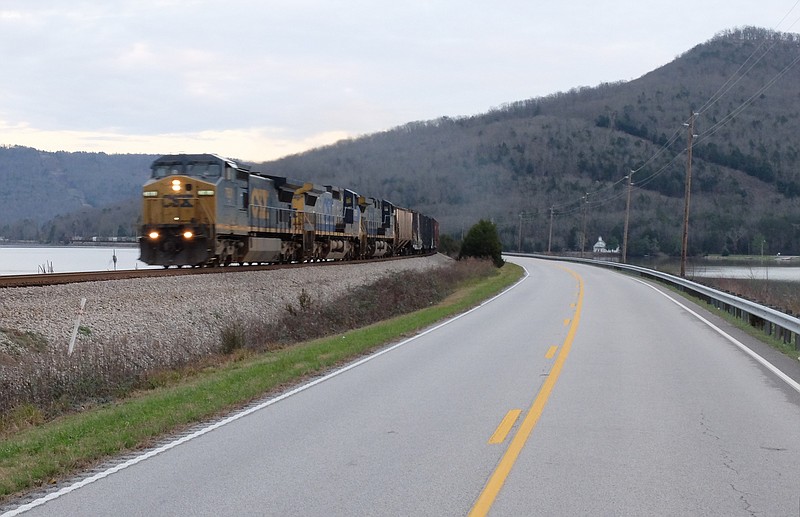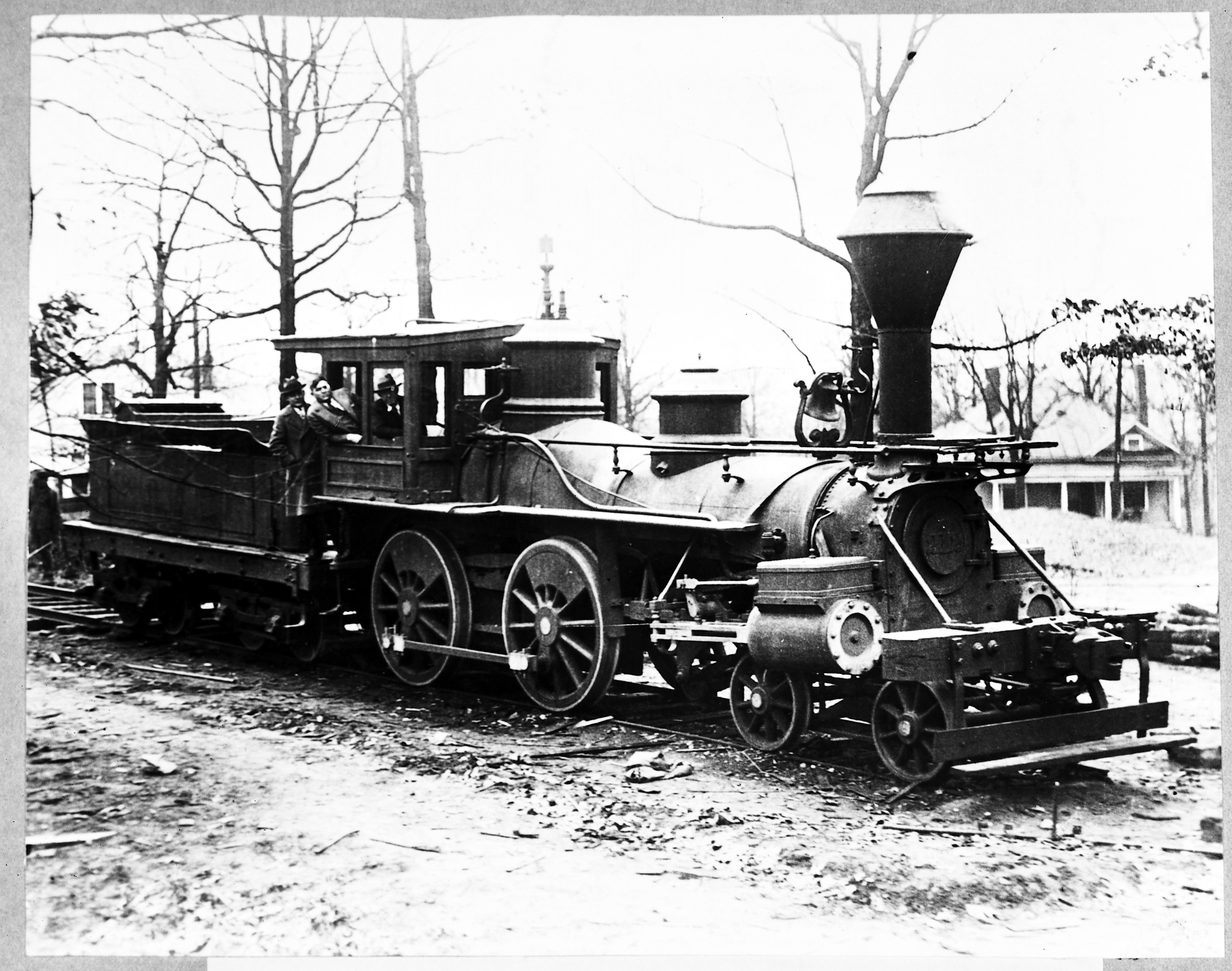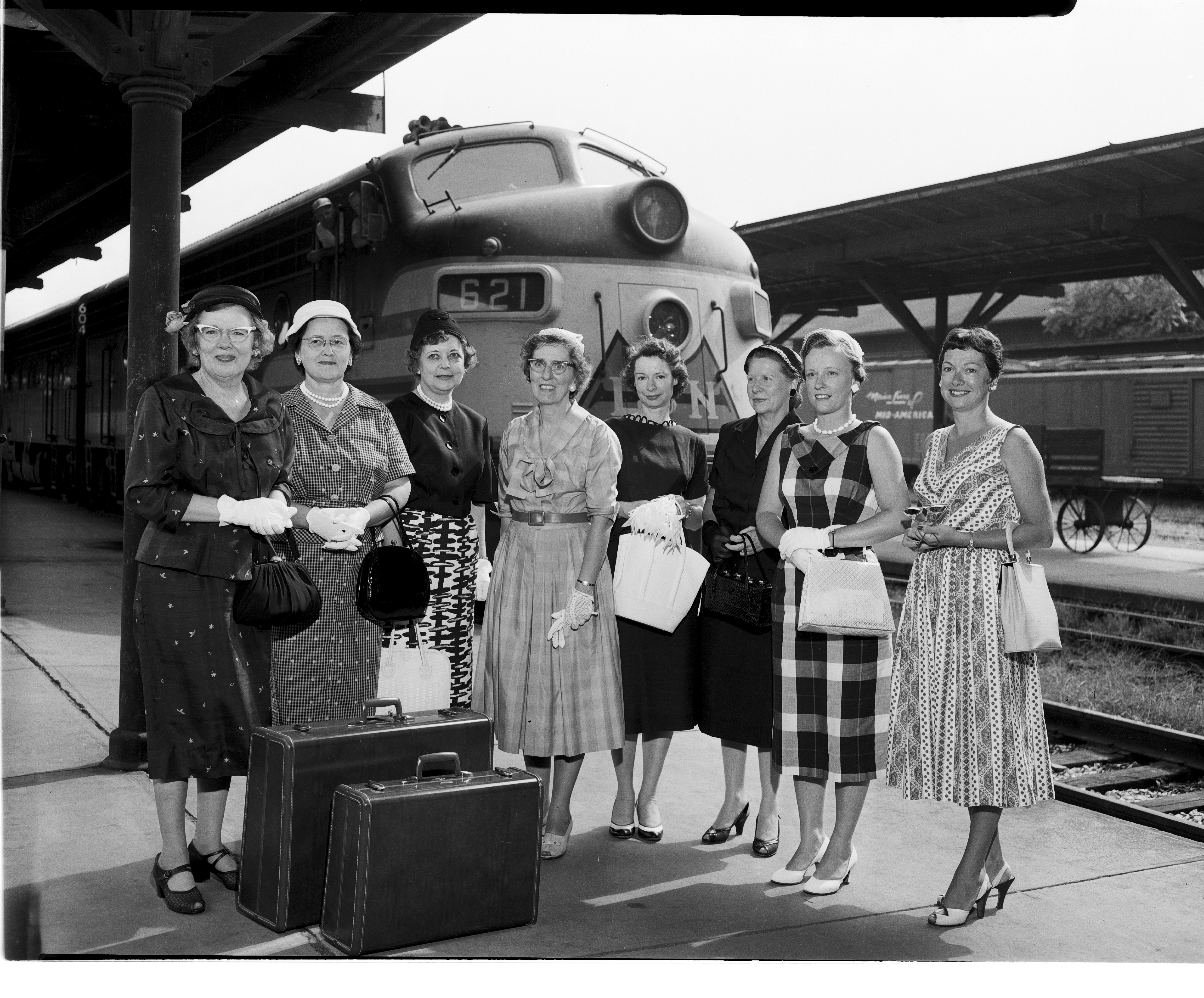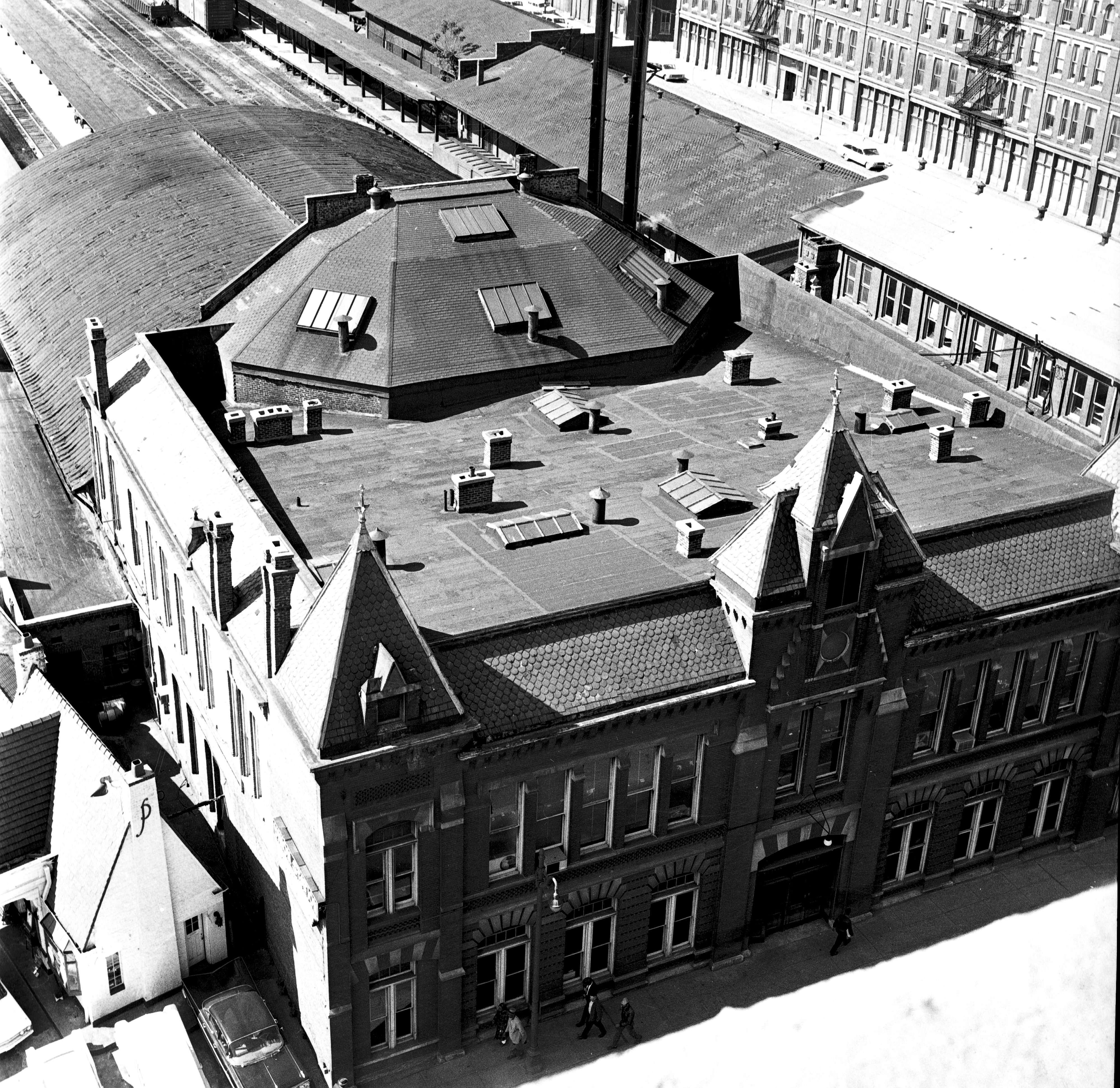One Friday in the spring of 1971, 5-year-old train enthusiast Michael Meadows and his grandmother boarded the northbound train to Nashville at Chattanooga's Union Station. Meadows' grandfather was a train man, The Chattanooga Times reported, and Michael Meadows hoped to follow suit.
Chances looked dim. Young Michael was set to board the last ticketed passenger train to Nashville. The very next passenger train to leave Union Station, southbound to Atlanta, would mark the end of commercial passenger rail service in Chattanooga.
Michael's mother, Mrs. William T. Meadows, said she had explained the situation to the boy. "But he just can't understand why he won't be able to ride the train back to Chattanooga when he's ready to come home," she told the Times.
In a city once defined by trains, a version of Michael's bewilderment would echo for the next half-century. Even intercity bus lines are now scarce. If you're a Chattanoogan who wants to get to Nashville, Birmingham, Alabama, Atlanta or someplace else, it's generally expensive or inconvenient to do so without a car.
Now, prompted by new potential federal infrastructure money and a sense that conditions are ripe for trains to reclaim their lost glory, lawmakers and advocates in Chattanooga are again talking of passenger rail lines to Nashville, Atlanta and beyond.
But, despite the existence of active freight lines between those and other destinations -- which generally run the same tracks on which passengers once rode -- the challenges are steep. State and local lawmakers have talked this talk before -- in every decade, in fact, since the most recent ticketed intercity passenger train left Chattanooga, more than 50 years ago. Is this time any different?
TRAIN FEVER
Trains, for many today, evoke the hearty spirit of a bygone era. Mark Brainard, who studies the archives at the Southern Railway Historical Association, remembers a grim passing of the guard in the 1980s at the novelty steam train line where he worked in various capacities around the South, as the old engineers failed to pass their wisdom and style to the next generation.
"You got these guys, 30 years old, used to running a diesel locomotive, that could not play the whistle," Brainard said from his office near the Tennessee Valley Railroad Museum. "They couldn't work the whistle to give it a soul, right?"
Trains, for people living before us, however, embodied the astonishing possibilities of modernity.
"Nineteenth-century Americans experienced this radical reordering of their sense of space and time," said William Thomas, a University of Nebraska historian of the Southern railroads.
People who have lived through the internet age might be able to relate, he said.
Picture yourself. You're in 1820s Savannah, Georgia, where life takes place at the speed you can walk.
But the newspapers carry strange tales: Across the sea, a miraculous device uses steam to move coal on roads of rail.
Skepticism was only natural. "There were doctors who said, 'Man cannot breathe air at such a high speed,'" Brainard said.
But train fever was spreading. People saw it as a transformational technology, Thomas said, "not just as an engine of progress, but as something that would transcend nature and help create a society of interconnected places."
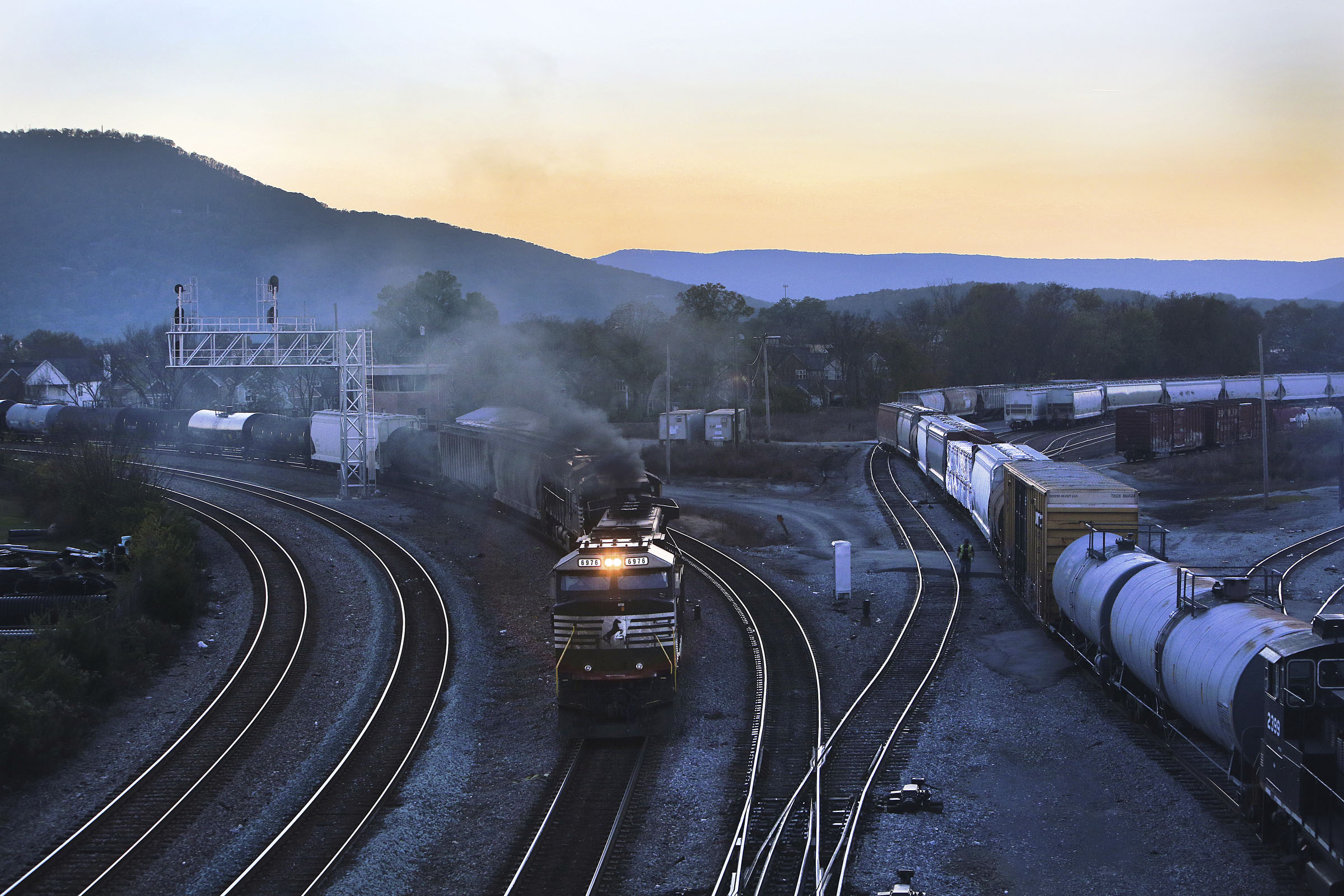 Staff photo by Erin O. Smith / .A Norfolk Southern freight train, lead by rebuild SD-60e no. 6976 makes it's way down the mainline as the sun sets near Central Avenue Monday, Nov. 13, 2017, in Chattanooga, Tenn. At the right Norfolk Southern MP-15DC locomotive, no. 2399 sorts cars at a local industry near the Choo-Choo. Know as East End, numerous trains a day traverse the area as the mainlines of both the Norfolk Southern and CSX railroads are just yards east of these yard tracks.
Staff photo by Erin O. Smith / .A Norfolk Southern freight train, lead by rebuild SD-60e no. 6976 makes it's way down the mainline as the sun sets near Central Avenue Monday, Nov. 13, 2017, in Chattanooga, Tenn. At the right Norfolk Southern MP-15DC locomotive, no. 2399 sorts cars at a local industry near the Choo-Choo. Know as East End, numerous trains a day traverse the area as the mainlines of both the Norfolk Southern and CSX railroads are just yards east of these yard tracks.Erin O. Smith
TRACKS LAID
To Georgia power brokers of the early 19th century, the Tennessee River promised access to the economies and raw goods of the West. Planners combed the maps. Between Lookout Mountain and Knoxville, there seemed to be a rare natural break in the Appalachian Range granting access to the river.
From Atlanta, builders headed northwest, dodged hills and small mountains, putting together a crooked railroad, full of sharp turns, often inhospitable to multiple tracks, Brainard said.
While paid workers likely numbered among them, the people digging dirt and laying tracks were often not working of their own free will. Thomas said he has consulted every annual report of a Southern railroad company before the Civil War. Those reports, produced for the benefit of shareholders, tallied profits, losses and assets -- in which category companies often reported the financial value of the people they enslaved.
Corporations in those days generally had to be chartered by local governments; their rights and purposes were approved by lawmakers. According to Brainard, Tennessee's had made a decree: the railroad must be in the state by 1849, lest the building company lose its rights.
By 1847 the tracks reached Dalton, Georgia, quite close to Chattanooga -- at least as the crow flies. But there was a mountain in the way. Squeezed for time, workers skipped over it, leaving the tunnel for later, Brainard said.
They laid tracks from the other side of Chetoogeta Mountain, and arrived in Chattanooga in late 1849, with the line terminating around what is now M.L. King Boulevard, Brainard said. Speculators, foreseeing a boom town, had bought everything for a mile up from the river.
Soon the tunnel was completed, and the Western & Atlantic Railroad linked Chattanooga to an emerging railroad network that extended to the Atlantic. The new train terminus had its flaws. Down river toward Signal Mountain in those pre-dam days turned out to be at times almost un-navigable, given the whirlpools -- "the suck," it was called -- a fact Indigenous groups were well aware of, Brainard said.
Still, Chattanooga's identity was set. Soon, new train lines stretched from Chattanooga into Knoxville and on toward mid-Atlantic cities. New tracks looped southwest with the river and then veered toward Nashville, supplanting the circuitous river routes or mud-slogged wagon trains through which, Brainard said, its wealthy citizens previously got their fabrics, cast iron or Champagne from France.
A WORLD CONNECTED
Chattanooga's rail and river connections helped make it a strategic treasure in the Civil War, and after the fierce fighting ended, the railroad system continued to chaotically grow.
"They duplicated routes all the time," said Richard White, a Stanford historian who has extensively studied the financing of the railroads. "If you want chaos -- and not everybody is going to agree with me on this -- leave it up to the private sector," he said by phone.
Though the federal government famously poured in money and land grants for the transcontinental railroads, the Southern railroad was mostly a state- and privately-funded affair. Even local governments eventually pulled out, however. The highly competitive railroads often lacked the traffic to sustain themselves, and by the 1870s, railroads were going bankrupt, often leaving the public holding the bag and engendering skepticism toward further government involvement, Thomas said.
The Jan. 19, 1880, New York Times captured the frantic energy of the train business, with an article describing "a vast railroad scheme." The Louisville and Nashville Railroad Co. had bought the Nashville and Chattanooga Railroad, putting to rest an epic rivalry in which, according to the paper, the latter company had "set secretly and vigorously to work to checkmate" their competitor through a bewildering array of secret purchases, corporate coups, stock manipulations and backroom deals aided by the "influence of Southern friends" -- until, at last, in a Fifth Avenue hotel in New York City, the primary stockholders of the Nashville and Chattanooga Railroad accepted there was nothing to do other than sign away their shares and cede "Southern Railroad Supremacy."
Chattanooga was the kind of place over which such a supremacy was sought. By the 1880s, Brainard said, snowbirds from Buffalo to Chicago funneled through Chattanooga, bound for the Florida winter. Trains conferred a unity upon the region. Chattanoogans in that time could take a train to many nearby railroad towns and onward toward every major city, to the south, to the west, to the coasts. The Chattanooga Times had a railroad editor, Brainard said, and its founder, Adolph Ochs, used privately chartered trains strategically to defeat his primary competitor, the Knoxville Sentinel, in a tug-of-war to provide news to railway towns in between.
But by the late 19th century, railroad executives had concluded that raft of passenger service was a consistent drain on a company's balance sheet, Thomas said. Freight moved en masse, with minimal labor and hassle relative to passenger service. Freight wouldn't die in a crash. Freight couldn't sue for negligence.
Still, the companies kept passenger service because of their charter requirements, and the peak of American ridership was yet to come. By the turn of the 20th century, rail remained "the only way to move across vast interior spaces," Thomas said. The beaux-arts Terminal Station opened in Chattanooga in 1909.
Trains for decades remained the medium for the nation and the events that shaped it. They carried mail and information. They enabled the Great Migration of African Americans from the South to cities and economic opportunities in the North. The federal government took control of the trains during World War I, coordinating rates and schedules in an effort to efficiently move soldiers from far-flung regions -- Nebraska, California -- to the eastern seaboard for deployment.
NEW MODES
David Steinberg's mother told him his first word was "bus." Born in 1939 in Alton Park at the corner of 38th and Pirola streets, he watched as train cars from the Incline Railway went up Lookout Mountain -- and from his porch as trains went back and forth, day and night -- the main line of the Southern Railway route to Birmingham.
Starting in the early 1950s, Steinberg took thousands of photos of the trains in Chattanooga during their slow and persistent 20th century decline and wrote multiple books on trains and buses as the world changed around him.
An Orthodox Jew, he moved to Brooklyn for religious reasons a few years after the last passenger trains left.
"The train is the way of life here," he said from New York in a phone interview.
"In the South, people are used to living in their car. They've got a marriage certificate with a car," he said. "It's the way it is. It's the way it is. But listen. I'd love to see the trains come back."
There are many theories to explain the decline of U.S. passenger rail. Historians weigh the role of regulation and unions, shoddy business practices, paltry government support or an independence-minded American spirit.
But according to Thomas, one major factor goes generally undisputed -- "the rise of the automobile and the public financing of the interstate highway system."
Buses and cars emerged, but for a while trains retained their advantages. Early-to-mid 20th century passenger trains between Atlanta and Chattanooga took about four hours, Brainard said. The competition was U.S. Highway 41, which took about as long and, in those early days of the internal combustion engine, entailed certain risks.
"Your fuel pump goes out, you've got to go knock on some barn or something," Brainard said. "You're out of luck in middle-of-nowhere Georgia."
That state of affairs didn't last. Cars became reliable. The federal government built major airports. Soon passenger salesmen, with all their luggage in tow, took the plane rather than the train, Brainard said.
Those trends reversed dramatically, if fleetingly, during World War II, when troops were on the move and rubber and gas were scarce.
"You couldn't get a seat on a train in Chattanooga," Steinberg said of those childhood years. "But after the war, it was all over. All over."
INTERSTATE ERA
Railroads in the 19th century expanded on the basis of vast public support, either from the federal or local governments, said White, the train historian. But he said there are major contrasts between that history and the profound nature of federal government involvement in the interstate highway system.
Envisioning that new system in the mid-20th century, planners heeded the lessons from the 19th, White said. They designed the system in a deliberate way -- with, generally, one route to get to one place, White said. And as they built it, the federal government maintained control of the infrastructure, rather than facilitating the ownership of private companies.
As contractors began to bulldoze vast rights of way through the hills around Chattanooga, the railroads -- whose original tracks were graded through thin rights of way with the power of mules -- languished. Passenger rail was frequently delayed by freight trains on lines that lacked side tracks. And the railroad companies had little space or money with which to expand.
Meanwhile, automobiles, though still prone to breakdowns, had moved well past the putt-putt days in which they left drivers marooned in rural Georgia on the road to Atlanta.
"You can get in your 1965 Impala and zoom down there at 70 miles an hour," Brainard said.
Steinberg was a child when he discovered microfilm at the public library -- and when he started documenting his own world, noticing the changes afoot. Where five trains went to Atlanta every day, there were four, he said. Six trains to Cincinnati became five.
Finally on Aug.12, 1970, The Chattanooga Times declared a moment long coming: "Historians can record 11:35 p.m., Thursday, Aug 11, 1970, as the end of an era in Chattanooga."
The last Southern Railway passenger train had left Chattanooga's Terminal Station, and the two major local papers agreed on the cause: costs were high, and riders were few.
Railway officials and employees came to Terminal Station to mark the occasion and take a final ride back to the Eastern Seaboard, a route made famous by America's first gold record, "Chattanooga Choo Choo." But few others showed up.
"Just a foolish fella named David Steinberg," Steinberg said.
The prior day happened that year to be Tisha b'av, a fasting holiday in the Jewish tradition, commemorating the destruction of two temples. Now he'd come to Terminal Station to reflect on a place that had long fascinated him.
In the front, those walls are 40-something inches thick, he said, with vitreous brick laid in an expensive flemish bond. Southern Railway workers had always welcomed him into his station, he said. They were his friends, and they invited his extensive photography.
Nearby Union Station, run at that point by Louisville & Nashville Railroad, lacked the same soaring beauty but still had much historical interest. One intercity passenger train still served Chattanooga from that station, but everyone knew its days were numbered. Federal lawmakers created Amtrak to relieve the passenger-carrying obligations of the private railroads in exchange for the right to pay to use their tracks -- and in its efforts to turn a profit, it would drop under-performing lines.
Rail unions and consumer groups protesting the cutback in service had sought to delay the start of the new system. But Amtrak won out. On May 1, 1971, the new carrier took over most of the nation's long-haul passenger rail service, and, as one newspaper put it, sent one-third of American passenger trains into history.
Riders took nostalgic final rides. Shrimp and champagne parties rocked aboard the Panama Limited run between Chicago and New Orleans. Young Michael Meadows, who dreamed of being like his grandfather, headed to Chattanooga's Union Station to take the last Northbound run of The Georgian -- his journey memorialized with a mournful headline: "Mike, 5, Rode Northbound Train But There'll Be No Return Trip."
A new era was at hand. That day, the front page of the Chattanooga News-Free Press featured a map of interstates snaking about the Eastern United States and declared the emerging system about three-fourths complete.
Work remained in spots, such as the Interstate 24 stretch up Monteagle Mountain. But the newspaper anticipated the fulfillment of what for many had long been just a dream: "The time would come when Americans could travel across the entire country and never face a red light or a stop sign."
NOSTALGIA AND DECAY
The Chattanooga stations' best days had passed well before the last commercial passenger trains ran. But by November of 1971, Union Station was grim. Spider webs covered old baggage wagon wheels. Few ventured within, save lovers, drunkards and the lone railroad official who continued to work there.
"Almost instinctively, he tries to keep the station looking neat," the News-Free Press reported, describing the man kicking glass off the old concrete loading platform. "But it's a big station, and he's the only person there. The place is very still, just a few lights on."
Historical societies and others sought to save the station -- once among the major railway hubs of the South and parts of which predated the Civil War. Those efforts, like many around the country in that era, were a failure: Louisville & Nashville sold part of its stake to developers, and the station was demolished in early 1973.
Terminal Station, of course, had more luck -- a fact Steinberg attributed to the fierce blowback the Southern Railway received upon razing its historical station in Birmingham.
"That saved Chattanooga," Steinberg said.
The company waited until preservationist-minded buyers came along.
When those buyers came, Steinberg heard they planned to maintain a small, nostalgic streetcar line, and he dreamed of operating it.
"But then I thought to myself 'David, come on, be realistic. Nobody's gonna hire a Jewish fellow that's not gonna work on Friday nights, not gonna work on Saturdays, he's wearing a beard.'"
He gave up the idea. But then he got a call from B. Allen Casey, who led the Terminal Station purchase -- and knew of Steinberg's railroad research. Steinberg showed Casey, who died in 2020, some of his archival collection.
"He went berserk," Steinberg said.
Steinberg said he took his chance and asked Casey if he would hire him to drive the trolley.
It went "nowhere," Steinberg said -- just a quick route around the station's property. But Steinberg loved the job, which he held into the 1980s, when he grew dismayed at the lack of Orthodox Judaism in town.
"My religion was more important to me, and I felt the void there," he said. "So I packed my bags and went to a place I despise with a passion, and that's called New York."
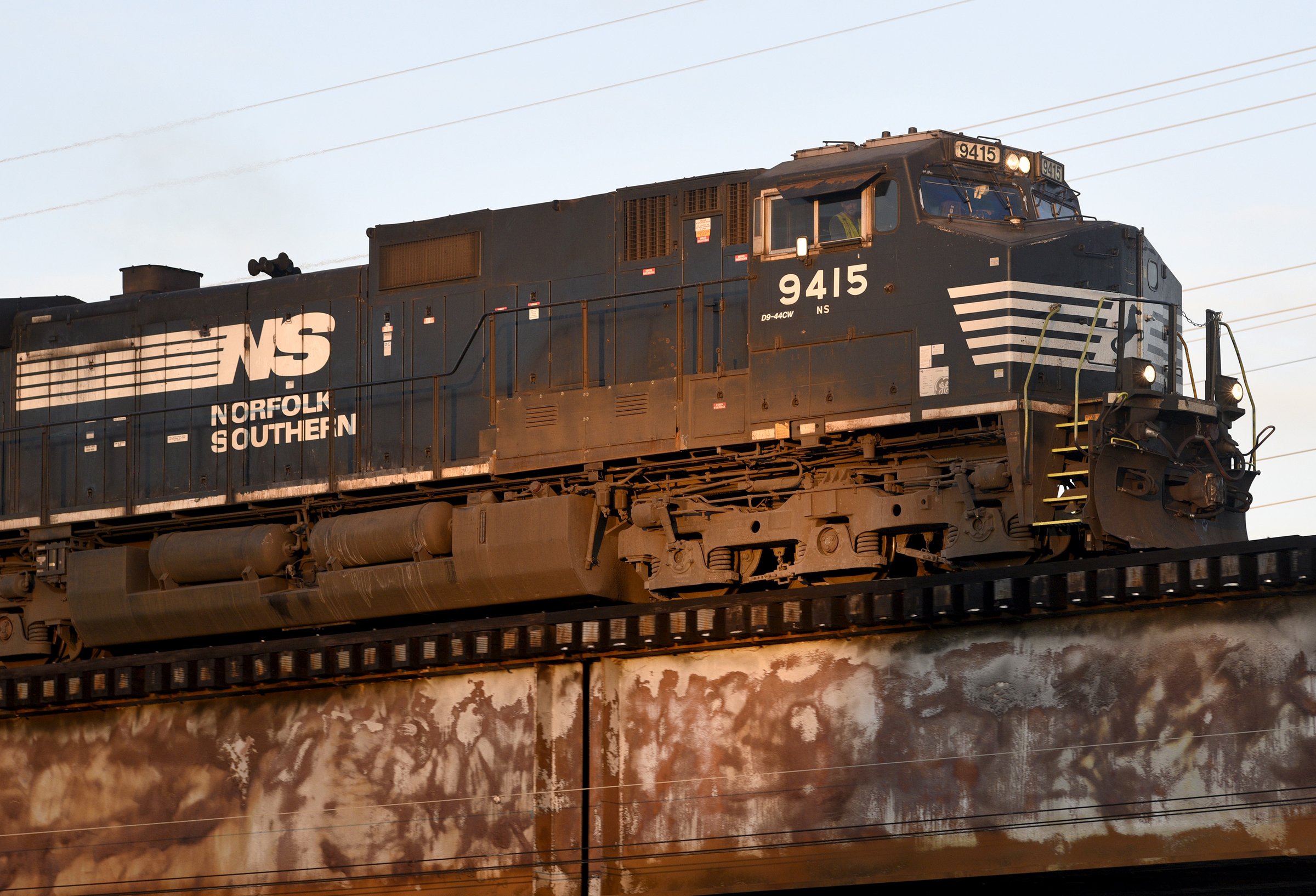 Staff Photo by Robin Rudd/ Engine 9415 leads a southbound Norfolk Southern stack train crosses the Tennessee River on the hundred year-old bridge, recently. According to Bridgehunter.com the first bridge was built for the Cincinnati Southern Railway and finished in 1886. The single rounded pier is the only part of the original bridge. The bridge was rebuilt from 1917 to 1920. Interestingly the bridge, often referred to as "Tennbridge," is still owned by the city of Cincinnati and leased by the Norfolk Southern Railway.
Staff Photo by Robin Rudd/ Engine 9415 leads a southbound Norfolk Southern stack train crosses the Tennessee River on the hundred year-old bridge, recently. According to Bridgehunter.com the first bridge was built for the Cincinnati Southern Railway and finished in 1886. The single rounded pier is the only part of the original bridge. The bridge was rebuilt from 1917 to 1920. Interestingly the bridge, often referred to as "Tennbridge," is still owned by the city of Cincinnati and leased by the Norfolk Southern Railway.Robin Rudd
TRAIN TALK
Today, Tennessee is alive with whispers of trains. Studies are commissioned. Federal money's flowing. Leaders are sending letters of interest.
State Rep. Yusuf Hakeem, D-Chattanooga, is cutting down on the number of bills he will present this legislative session so he can focus on his work building a passenger rail coalition, he said by phone a few days ago. He thinks Chattanoogans could be boarding passenger trains by 2026.
The city, as residents can often perceive, remains a train hub. The same old companies still run on the same old track network -- though their names are a little different.
CSX, which still runs trains to Atlanta and Nashville, evolved in part from the Louisville & Nashville Railroad, among others. And a Southern Railway merger produced Norfolk Southern Railway, which has a large yard in town and sends freight trains north toward Cincinnati, east toward Knoxville, south toward Atlanta, west toward Birmingham.
Can't passenger trains just run on those lines? Brainard is skeptical. The old problem of narrow windy one-track wide routes would mean frequent delays, he suspects. A passenger line to Knoxville might not be so tricky, but in the mountains, sidetracks are few, and additional rails would be highly expensive to add, he said. Plus, the freight companies would need to be on board, and he thinks they would be wary of sharing the Atlanta route in particular.
"They'll tell them (Amtrak), 'You've got to build your own track. You've got to build it like an interstate. We're busy,'" he said.
By law, railroads like CSX have to give priority to Amtrak passenger trains, which outside the Northeast corridor rarely owns the tracks it uses. But in practice, the negotiations are often difficult and have been known to delay or dash passenger rail dreams.
But passenger rail advocates sense a changing climate. As, following passage of a major infrastructure bill in 2021, the federal government makes what it calls the biggest investment in passenger rail since the creation of Amtrak, public officials across the country are scheming and hoping together.
At a hearing Friday, along with Tennessee lawmakers and transportation leaders in Nashville, rail officials from Amtrak and two states related their own recent experiences expanding passenger rail.
Virginia sought not to force the freight company on the legal requirement to facilitate passenger rail, fearing bad passenger service would result, said Mike McLaughlin, chief operating officer with Virginia Passenger Rail Authority. He said the state instead sought to establish win-win arrangements -- new track expansions or outright purchases, for example -- benefiting both the state and the company.
Hakeem, by phone, said he imagines in some areas a new track will be necessary, but he thinks new logistics technology will ease negotiations with CSX and Norfolk Southern.
"One of the factors is timing," he said, "and we feel that can be overcome."
IT'S COME UP BEFORE
As Hakeem knows from his decades in local government, Chattanoogans have seen this talk before.
To name just one 1980s example, Amtrak considered a new route connecting Nashville and Savannah by way of Chattanooga -- much like lawmakers are sketching out today. The 1990s and 2000s saw a familiar cycle -- but now charged with the promise of new technology.
Cleveland, Tennessee's then-mayor, Tom Rowland, spoke to the News-Free Press in 1992 of excellent chances for a new high-speed route on existing tracks between Washington, D.C., and Chattanooga. The new trains, he'd been led to believe, traveled at 125 mph and tilted at the curves, he said.
Next came maglev trains, which glide at high speed atop a magnetic field. Around the new millennium, a coalition of mayors failed to secure funding for a project using the technology, but they remained hopeful.
"We will see high-speed train service between Chattanooga and Atlanta in the near future," then-Mayor Jon Kinsey of Chattanooga told the Chattanooga Times Free Press in 2001.
Trains often pull bipartisan support, and in time some politicians came to believe a deeper re-imagining was in order.
"I think if you really want a successful high-speed rail network, then you have to throw the ball deep," said Zach Wamp, then a congressman representing Chattanooga, around 2008. "Think like Dwight Eisenhower did with the interstate highway system in the 1950s and put more money in this and look for bolder technology."
VALUE PROPOSITION
Chattanooga's latest plan, focused on short-term feasibility, is far more modest.
"We don't want to miss good for the perfect," Chattanooga Mayor Tim Kelly said during a visit to the Chattanooga Times Free Press offices Thursday.
While high-speed would be great in the future, using existing lines would be more financially feasible, said Kelly's chief of staff, Joda Thongnopnua, who said he has reviewed past passenger rail studies for the area. Such was Kelly's vision when, in December, he joined the mayors of Savannah, Atlanta and Nashville in signing a letter to the Federal Railroad Administration expressing interest in passenger rail linking the cities.
They were eying a new federal program, which offers funding and support to initiate new train corridor studies around the U.S. At the meeting in Nashville on Friday, Nicole Bucich, who heads network development for Amtrak, said the Corridor I.D. program was easy to apply to, and was now the best -- and really, only -- way for local governments to apply for inter-city passenger rail expansion.
The deadline for the first round of applications is March 20 -- a date Tennessee plans to let pass while it awaits a rail study scheduled for delivery later in the year.
State transportation leaders, currently planning their own car-centric efforts to limit traffic congestion, say they're still interested, and Bucich said there will be a future Corridor I.D. application round, likely in 2024. But in a somewhat unusual arrangement, the group of mayors will themselves apply for the specific Nashville-to-Savannah corridor before the March 2023 deadline, Kelly said, which would mean a federally-backed study of that route could still potentially begin in earnest soon.
It is unclear, many decades later, if travel times along that route could compete with, say Interstate 75 to Atlanta. Absent a massive reforging of the rail lines, Brainard doubts it, and Kelly said if initial studies show the train trip to Atlanta would take something like four hours, the city probably wouldn't bother pursuing the idea further.
The other question, he said, is where and how often the train would stop. Advocates believe that, today as ever, trains have the potential to remake a place, and towns along the routes will no doubt pine to be included in any passenger rail plan.
"But if it stops too often," Kelly said, "then you destroy the value proposition."
Contact Andrew Schwartz at aschwartz@timesfreepress.com or 423-757-6431.
